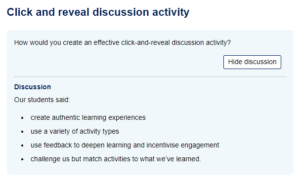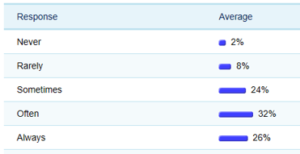You may be familiar with click-and-reveal discussion activities. These are simple learning activities, which ask students to consider a question and then click to reveal an answer, some further discussion or feedback. This type of question—feedback device can be seen in face-to-face classroom environments when a lecturer poses a question to the class and then provides verbal feedback on students’ responses.
In distance learning delivered in print, questions can be posed within text and answers provided at the end of the book or feedback provided directly after the question. In an
 online virtual learning environment, students read a question onscreen, answer it (sometimes using a fill-in text box) and then click a button to reveal a discussion or feedback.
online virtual learning environment, students read a question onscreen, answer it (sometimes using a fill-in text box) and then click a button to reveal a discussion or feedback.
Some students enjoy the fast reward provided by click-and-reveal discussion activities, whilst others find them dissatisfying and low value. Could this divided opinion be due to the type of activity or relate more to the how the activities are designed? To understand more about how Open University (OU) students engage with click-and-reveal discussion activities and how well they aid their learning, we asked our Curriculum Design Student Panel about their experiences with this type of activity via a short survey. The panel is comprised of OU students and whose experiences and opinions inform design decisions on OU modules.
What did students tell us?
The responses to this survey numbered 362 and of those only 6% (22) reported never having encountered a click-and-reveal discussion activity in the OU modules they had studied. When asked how often they made an attempt to answer the question posed, 58% students (210) responded ‘always’ or ‘often’.

A detailed analysis of the data revealed that the most experienced students (those studying at Level 3 students or post-graduate level) were less likely to engage with click-and-reveal discussion activities than Level 1 and 2 students. Also, Faculty of Business and Law students interacted with these activities much less than average, and Faculty of Wellbeing, Education and Language Studies students engaged with them much more than average.
The survey revealed that students’ attitudes to click-and-reveal discussion activities fall into four roughly equal categories: highly positive experiences; engaged to a limited extent; those who felt the activities would benefit from modification; and negative experiences.
Students who had a highly positive experience found click-and-reveal discussion activities a useful means to actively engage with and reflect on the module content. They found the activities to be a low risk mechanism to test themselves on their knowledge and found them useful in that the ‘reveal discussion’ part presents the material in an alternative way that aids understanding.
Where engagement with the activities was to a limited extent, students decided to constrain their engagement by only:
- writing brief answers for example as a bullet point list
- thinking about the answer but not actually writing anything down
- reading the revealed answer without answering it at all
- attempting the activity if it related to an assessment.
Those students who felt the activities would be more useful if modified, said that the activities would work better if they could be assessed, either by making them multiple choice, or by using AI to analyse their free text responses, or through peer evaluation, either through tutor group forums or by a ranking system. It was also mentioned that using the questions as a prompt to generate notes that could be used for revision was also a positive aspect of the activities.
The activities prompted a negative experience for some students because they interrupted their flow and focus on the reading. Issues were also raised with the content of some activities in that they sometimes provided answers that students did not feel matched what they had learned to that point, were superficial in design or in the types of answers given and so appeared to lack value, and could be demotivating when the discussion highlighted a lack of understanding.
Top tips for designing effective click-and-reveal discussion activities
- Create authentic learning experiences
Avoid the tendency to simply use the click-and-reveal discussion as a means to present more reading under the disguise of an activity, as this feels inauthentic to students. Instead use them where they are an appropriate method to allow students to test and expand their understanding.
- Use a variety of activity types
Don’t rely on click-and-reveal discussion activities as a predominant activity type. Use a variety of activities to keep students engaged and aid retention (Van Ameijde et al., 2015).
- Use feedback to deepen learning and incentivise engagement
Feedback must:
- Relate to what students have been asked to do
- be at an appropriate level
- enable students to learn, even if they have not provided the expected answer.
For example, use epistemic ‘triple loop’ feedback there is a need to develop independent learning (Kirschner and Neelen, 2018), but also use activities which provide less intensive forms of feedback such as pattern matching activities, multiple choice questions or peer evaluation.
- Challenge students but match activities to what they’ve learned
It is important to ensure that activities represent actual knowledge or skills students could have acquired at that point and are useful for the students’ learning.
Thanks
Thanks to Learning Design team friend Mark Childs for his contributions to this research and its outputs.
References
Van Ameijde, J., Cross, S. and Weller, M. (2015) Designing for student retention. The ICEBERG Model and Key Design Tips [Online]. Available at https://blog.edtechie.net/learning-design/designing-for-retention-the-iceberg-model/ (Accessed 10 September 2020)
Kirschner, P. A. and Neelen, M. (2018) ‘No feedback, no learning’ 3-star learning experiences [Online]. Available at https://3starlearningexperiences.wordpress.com/2018/06/05/no-feedback-no-learning/ (Accessed 10 September 2020)

